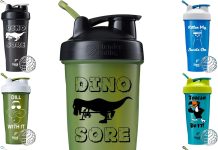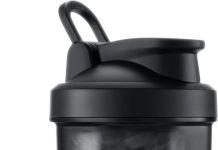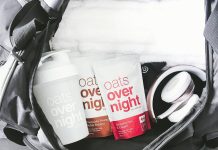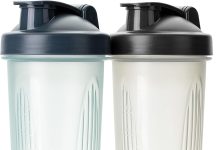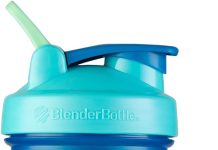Blender Bottles, those nifty gadgets that keep our smoothies, protein shakes, and other concoctions well-mixed on the go, have become a trusted companion for many of us. But have you ever wondered what materials these handy containers are actually made of? From the sturdy body to the leak-proof lid, Blender Bottles are meticulously designed using a combination of durable plastic materials that are both safe and convenient for everyday use. In this article, we’ll uncover the secrets behind the construction of these popular shakers and delve into the quality materials that make them the ultimate companion for all your blending needs.
Review contents
What are Blender Bottles made of?
This image is property of www.blenderbottle.com.
Introduction to Blender Bottles
Blender Bottles have become an essential item for fitness enthusiasts, health-conscious individuals, and those who enjoy homemade smoothies or protein shakes on the go. These bottles are specially designed to efficiently mix powders and liquids, ensuring a smooth and lump-free drink. But have you ever wondered what materials are used to create these convenient bottles? In this article, we will explore the various materials used in Blender Bottles, including plastic, stainless steel, and glass, along with their advantages and potential drawbacks.
Materials Used in Blender Bottles
Blender Bottles are crafted using different materials, each offering unique benefits and considerations. The three primary materials used in the production of Blender Bottles are plastic, stainless steel, and glass. These materials are carefully selected to ensure durability, ease of use, and safety for consumers.
This image is property of www.blenderbottle.com.
1. Plastic
Plastic is one of the most commonly used materials in the manufacturing of Blender Bottles. It is highly favored due to its durability, lightweight nature, and affordability. The plastic used in Blender Bottles is typically BPA-free, meaning it does not contain bisphenol A, a chemical known to have potential health risks.
1.1 Types of Plastic Used
There are several types of plastic commonly used in Blender Bottles, including high-density polyethylene (HDPE) and polypropylene (PP). HDPE is a sturdy and resistant plastic that lends itself well to everyday use, making it an excellent choice for Blender Bottles. PP, on the other hand, offers superior resistance to heat and chemicals, ensuring the longevity of the bottle and the safety of its contents.
1.2 Benefits of Plastic in Blender Bottles
The use of plastic in Blender Bottles brings several advantages. Firstly, plastic is lightweight, making it convenient to carry around, especially during workouts or when traveling. Additionally, plastic bottles are durable and less prone to damage from accidental drops or impacts. Furthermore, plastic Blender Bottles are often dishwasher-safe, making them easy to clean and maintain. Lastly, plastic bottles provide excellent value for money, as they are typically more affordable than alternatives such as stainless steel or glass.
1.3 Potential Concerns
While plastic Blender Bottles offer many benefits, there are also potential concerns associated with their use. Plastic, especially when exposed to high temperatures or acidic liquids, may release small amounts of chemicals into the contents of the bottle. Although the plastic used in Blender Bottles is typically BPA-free, it is still advisable to avoid exposing plastic bottles to extreme heat or harsh chemicals to ensure the longevity and safety of the bottle.
This image is property of www.blenderbottle.com.
2. Stainless Steel
Stainless steel Blender Bottles have gained popularity in recent years due to their durability and sleek design. These bottles are typically made from food-grade stainless steel, which is resistant to corrosion and maintains the integrity of the container.
2.1 Advantages of Stainless Steel
Stainless steel Blender Bottles offer several advantages. Firstly, stainless steel is highly durable and less prone to dents and scratches compared to plastic or glass. This makes stainless steel bottles an ideal choice for individuals who lead an active lifestyle or participate in outdoor activities. Moreover, stainless steel bottles retain the temperature of the contents for longer periods, keeping beverages hot or cold as desired. They also provide a more premium look and feel, adding a touch of elegance to your drinkware collection.
2.2 Potential Drawbacks
Despite their numerous advantages, stainless steel Blender Bottles do have a few potential drawbacks. Firstly, stainless steel bottles are generally heavier than their plastic counterparts, which may be a consideration for those looking for a lightweight option. Additionally, stainless steel bottles can be more expensive than plastic bottles, although they offer enhanced durability and longevity. Lastly, some stainless steel bottles may not be dishwasher-safe, requiring manual cleaning, which can be time-consuming for individuals with a busy lifestyle.
This image is property of www.blenderbottle.com.
3. Glass
While less common than plastic or stainless steel, glass Blender Bottles have their own unique qualities that make them a preferred choice for some individuals. Glass is a non-reactive material that does not absorb odors or flavors, ensuring the purity and integrity of the beverage inside.
3.1 Glass as a Blender Bottle Material
Glass Blender Bottles are typically made from borosilicate glass, a type of glass known for its exceptional strength and resistance to thermal shock. This means that glass Blender Bottles can withstand rapid temperature changes without cracking or shattering, making them suitable for blending both hot and cold beverages.
3.2 Pros and Cons of Glass in Blender Bottles
There are both advantages and disadvantages to using glass Blender Bottles. One significant advantage is that glass does not leach any chemicals into the contents, ensuring a pure and untainted taste. Glass is also easy to clean and maintain, as it is dishwasher-safe and resistant to staining. Additionally, glass bottles offer a visually appealing design that enhances the presentation of your beverages.
However, glass Blender Bottles are more fragile than their plastic or stainless steel counterparts, making them more susceptible to breakage if dropped or mishandled. Glass bottles are also heavier than plastic bottles, which may not be ideal for individuals who prioritize portability.
This image is property of www.blenderbottle.com.
Conclusion
Blender Bottles are indispensable tools for blending smoothies, protein shakes, and other beverages on the go. The materials used in Blender Bottles vary, each offering unique advantages and considerations. Plastic bottles are lightweight, durable, and affordable, while stainless steel bottles provide enhanced durability, temperature retention, and a sleek design. Glass bottles offer purity, resistance to odors, and ease of cleaning. Ultimately, the choice of material for the Blender Bottle depends on individual preferences and priorities. Whether you opt for plastic, stainless steel, or glass, Blender Bottles are sure to enhance your blending experience and make it easier to enjoy delicious and nutritious drinks anytime, anywhere.








